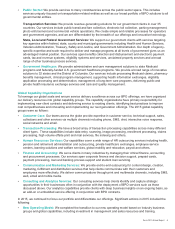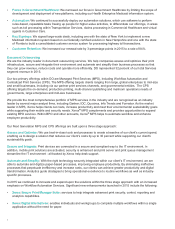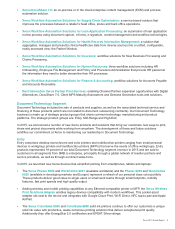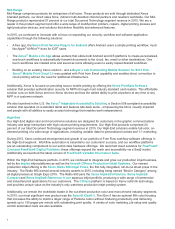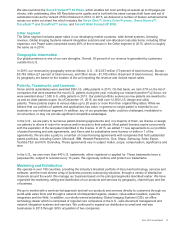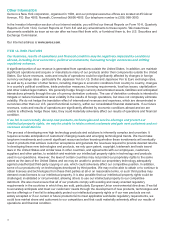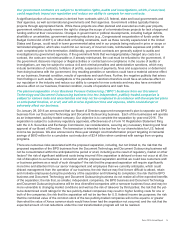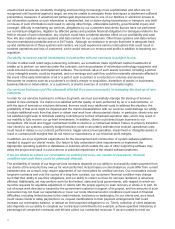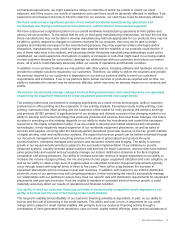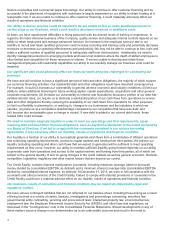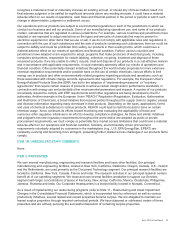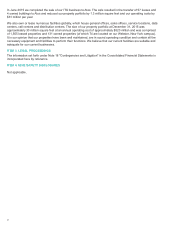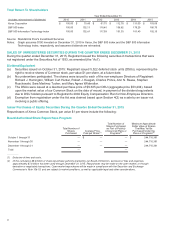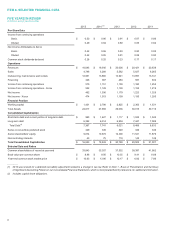Xerox 2015 Annual Report Download - page 33
Download and view the complete annual report
Please find page 33 of the 2015 Xerox annual report below. You can navigate through the pages in the report by either clicking on the pages listed below, or by using the keyword search tool below to find specific information within the annual report.resistance and/or competition. If we are unable to obtain adequate pricing for our services and products, it could
materially adversely affect our results of operations and financial condition. In addition, our services contracts are
increasingly requiring tighter timelines for implementation as well as more stringent service level metrics. This
makes the bidding process for new contracts much more difficult and requires us to adequately consider these
requirements in the pricing of our services.
We continually review our operations with a view towards reducing our cost structure, including reducing our
employee base, exiting certain businesses, improving process and system efficiencies and outsourcing some
internal functions. We from time to time engage in restructuring actions to reduce our cost structure. If we are
unable to continue to maintain our cost base at or below the current level and maintain process and systems
changes resulting from prior restructuring actions, it could materially adversely affect our results of operations and
financial condition.
In addition, in order to continually meet the service requirements of our customers, which often includes 24/7
service, and to optimize our employee cost base including our back-office support, we often locate our delivery
service and back-office support centers in lower-cost locations, including several developing countries.
Concentrating our centers in these locations presents a number of operational risks, many of which are beyond our
control, including the risks of political instability, natural disasters, safety and security risks, labor disruptions;
excessive employee turnover and rising labor rates. These risks could impair our ability to effectively provide
services to our customers and keep our costs aligned to our associated revenues and market requirements.
Our ability to sustain and improve profit margins is dependent on a number of factors, including our ability to
continue to improve the cost efficiency of our operations through such programs as Lean Six Sigma, the level of
pricing pressures on our services and products, the proportion of high-end as opposed to low-end equipment sales
(product mix), the trend in our post-sale revenue growth and our ability to successfully complete information
technology initiatives. If any of these factors adversely materialize or if we are unable to achieve and maintain
productivity improvements through design efficiency, supplier and manufacturing cost improvements and
information technology initiatives, our ability to offset labor cost inflation, potential materials cost increases and
competitive price pressures would be impaired, all of which could materially adversely affect our results of
operations and financial condition.
We are subject to laws of the United States and foreign jurisdictions relating to individually identifiable
information, and failure to comply with those laws, whether or not inadvertent, could subject us to legal
actions and negatively impact our operations.
We receive, process, transmit and store information relating to identifiable individuals, both in our role as a service
and technology provider and as an employer. As a result, we are subject to numerous United States (both federal
and state) and foreign jurisdiction laws and regulations designed to protect individually identifiable information,
including the Health Insurance Portability and Accountability Act of 1996 (HIPAA) and the HIPAA regulations
governing, among other things, the privacy, security and electronic transmission of individually identifiable health
information, and the European Union Directive on Data Protection (Directive 95/46/EC). Other United States (both
federal and state) and foreign jurisdiction laws apply to our processing of individually identifiable information and
these laws have been subject to frequent changes, and new legislation in this area may be enacted at any time. For
example, the recent invalidation of the U.S.-EU Safe Harbor regime will require us to implement alternative
mechanisms in order for some of our data flows from Europe to the United States to comply with applicable law.
Changes to existing laws, introduction of new laws in this area, or failure to comply with existing laws that are
applicable to us may subject us to, among other things, additional costs or changes to our business practices,
liability for monetary damages, fines and/or criminal prosecution, unfavorable publicity, restrictions on our ability to
obtain and process information and allegations by our customers and clients that we have not performed our
contractual obligations, any of which may have a material adverse effect on our profitability and cash flow.
We are subject to breaches of our security systems and service interruptions which could expose us to
liability, impair our reputation or temporarily render us unable to fulfill our service obligations under our
contracts.
We have implemented security systems with the intent of maintaining the physical security of our facilities and
protecting our customers', clients' and suppliers' confidential information and information related to identifiable
individuals against unauthorized access through our information systems or by other electronic transmission or
through the misdirection, theft or loss of physical media. These include, for example, the appropriate encryption of
information. Despite such efforts, we are subject to breach of security systems which may result in unauthorized
access to our facilities and/or the information we are trying to protect. Because the techniques used to obtain
Xerox 2015 Annual Report 16


